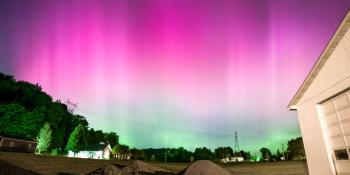Viewing archive of czwartek, 25 marca 2010
Raport aktywności słonecznej
Any mentioned solar flare in this report has a scaling factor applied by the Space Weather Prediction Center (SWPC). Because of the SWPC scaling factor, solar flares are reported as 42% smaller than for the science quality data. The scaling factor has been removed from our archived solar flare data to reflect the true physical units.
Raport aktywności słoneczno- geomagnetycznej 2010 Mar 25 2201 UTCPrzygotowane przez NOAA © SWPC i przetworzone przez SpaceWeatherLive.com
Połączenie raportów USAF/NOAA o słonecznej i geofizycznej aktywności
Numer SDF 084 wydany w 2200Z na 25 Mar 2010IA. Analiza aktywności regionów słonecznych i aktywność od 24-2100Z do 25-2100Z Solar activity has been at very low levels for the past
24 hours. Region 1057 (N15E45) has shown steady growth in area (400
millionths) and is still classified as a D group. Several B-class
flares were observed from Region 1057, the largest being a B7,
optically uncorrelated event, at 25/0433Z. A far-sided CME was
observed at 25/0128Z with an associated Type II radio sweep (shock
velocity 1395 km/s), but does not look to be geoeffective. Region
1058 (N27W06) was numbered today and is classified as a simple A
group.
IB. Prognoza aktywności słonecznej
Solar activity is expected to be at
very low to low levels. There is a chance for C-class flares from
Region 1057.
IIA. Podsumowanie aktywności geofizycznej 24-2100Z do 25-2100Z
The geomagnetic field has been at quiet to unsettled levels for the
past 24 hours. Solar wind observations from the ACE spacecraft
showed an increase of wind speed from 300 to 430 km/s following a
rise in density (1 to 22 p/cc). These signatures are indicative of a
co-rotating interactive region in advance of a weak coronal hole
high-speed stream.
IIB. Prognoza aktywności geofizycznej
The geomagnetic field is
expected to remain at quiet to unsettled levels for day one (26
March) as the effects of the coronal hole high-speed stream subside.
On day two (27 March), quiet levels are expected. On day three (28
March), the geomagnetic field is expected to be at quiet to
unsettled levels as a new coronal hole high-speed stream becomes
geoeffective.
III. Prawdopodobieństwa zdarzenia 26 Mar do 28 Mar
| Klasa M | 05% | 05% | 05% |
| Klasa X | 01% | 01% | 01% |
| Proton | 01% | 01% | 01% |
| PCAF | green | ||
IV. Przepływ 10,7 cm z Penticton
Zaobserwowano 25 Mar 088 Przewidywane 26 Mar-28 Mar 088/089/089 Średnia z 90 dni 25 Mar 083
V. Indeks geomagnetyczny A
Zaobserwowano Afr/Ap 24 Mar 002/003 Szacowane Afr/Ap 25 Mar 005/007 Przewidywane Afr/Ap 26 Mar-28 Mar 005/005-005/007-007/008
VI. Prawdopodobieństwa aktywności geomagnetycznej 26 Mar do 28 Mar
| A. Średnie szerokości geograficzne | |||
|---|---|---|---|
| Aktywne | 20% | 05% | 20% |
| Słaba burza | 01% | 01% | 05% |
| Bardzo znacząca burza | 01% | 01% | 01% |
| B. Wysokie szerokości geograficzne | |||
|---|---|---|---|
| Aktywne | 10% | 05% | 20% |
| Słaba burza | 01% | 01% | 05% |
| Bardzo znacząca burza | 01% | 01% | 01% |
All times in UTC
<< Idź do codziennego przeglądu
Najnowsze wiadomości
Najnowsze wiadomości z forum
What makes AR3684 magnetically distinct from AR3685? 6Filaments and prominences 129Latest SC25 Predictions 126Unproven theories 481AR3664 1072
Więcej tematówWesprzyj SpaceWeatherLive.com!
Wielu ludzi odwiedza SpaceWeatherLive aby śledzić aktywność słoneczną lub sprawdzić czy jest szansa na zaobserwowanie zorzy polarnej. Niestety, większy ruch na stronie oznacza większe koszty utrzymania serwera. Dlatego, jeśli jesteś zadowolony ze strony SpaceWeatherLive, zachęcamy do wspierania nas finansowo. Dzięki temu będziemy mogli utrzymać naszą stronę.

Fakty na temat pogody kosmicznej
| Ostatnie rozbłyski klasy X | 2024/05/15 | X2.9 |
| Ostatnie rozbłyski klasy M | 2024/05/17 | M7.1 |
| Ostatnia burza geomagnetyczna | 2024/05/17 | Kp6 (G2) |
| Spotless days | |
|---|---|
| Ostatni dzień bez skazy | 2022/06/08 |
| Monthly mean Sunspot Number | |
|---|---|
| kwietnia 2024 | 136.5 +31.6 |
| maja 2024 | 157.7 +21.2 |
| Last 30 days | 171.7 +57.7 |


